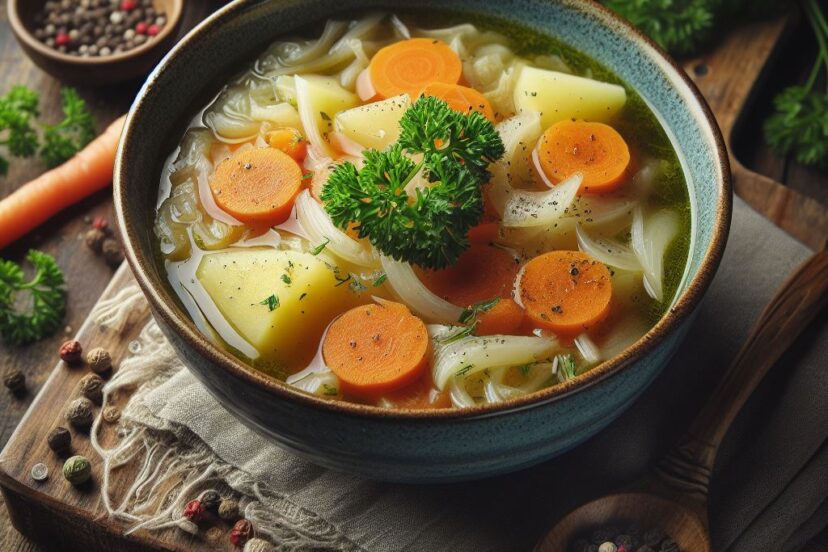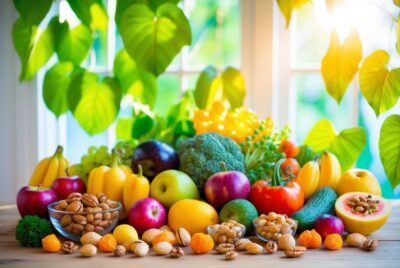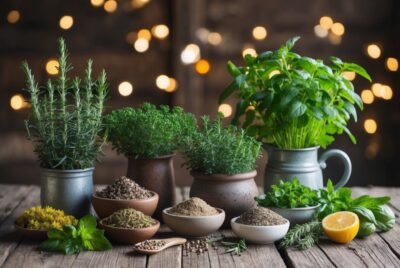Cabbage Diet Soup Recipe: Deliciously Simple
*We may earn a commission for purchases made using our links. Please see our disclosure to learn more.
Cabbage Diet Soup Recipe: Your Guide to a Healthy, Simple Meal
Cabbage diet soup recipe is recognized for its potential to help with weight loss. Its central ingredient, cabbage, is packed with fiber, which aids in digestion and creates a feeling of fullness, contributing to lower calorie intake throughout the day. I’ve found that making cabbage soup is quite simple, requiring just a few common vegetables and broth as its base. Adding a dash of vinegar can enhance flavor without increasing calories, making it not only a tool for weight loss but also a satisfying meal.

With an emphasis on health and nutrition, the cabbage soup diet offers a way to kickstart a reduction in body weight. This soup is typically low in calories and high in fiber, aligning with the principles of a balanced diet. While it can be an integral part of a more comprehensive diet plan, I always recommend being mindful of nutritional needs and consulting with health professionals when drastically changing eating habits.
This recipe for cabbage diet soup is also wonderfully versatile. It can serve as a foundational recipe that you can customize with your preferred vegetables or spices. Whether you adhere strictly to the seven-day plan often associated with this diet or simply incorporate the soup into your regular meal rotation, it’s a hearty dish that can support your health goals without sacrificing flavor.
Cabbage Soup Diet Overview

In this section, I’m going to provide a detailed look at the cabbage soup diet, a 7-day meal plan designed primarily for weight loss. I’ll cover the basic structure of the diet and discuss the potential health benefits and considerations associated with it.
Basics of the 7-Day Diet Plan
The cabbage soup diet is structured as a low-calorie diet centered around a large intake of cabbage soup. Here’s the basic framework of the 7-day meal plan:
- Day 1: Unlimited cabbage soup and fruit (except bananas).
- Day 2: Unlimited cabbage soup and other non-starchy vegetables.
- Day 3: A combination of days 1 and 2; no bananas or starchy vegetables.
- Day 4: Cabbage soup, bananas, and skim milk.
- Day 5: Cabbage soup and a serving of lean protein such as chicken or fish.
- Day 6: Cabbage soup, along with lean protein and vegetables.
- Day 7: Cabbage soup, brown rice, vegetables, and unsweetened fruit juice.
During this diet, the primary focus is on the soup, which is made from cabbage – a vegetable low in calories yet rich in vitamin C, fiber, potassium, antioxidants, calcium, and iron.
Health Benefits and Considerations
Adopting the cabbage soup diet may lead to rapid weight loss due to its low-calorie nature. The high volume of water and fiber can also assist in creating a feeling of fullness, which helps in reducing overall calorie intake. The vegetables used are generally packed with essential nutrients, potentially aiding in a detoxification process by supporting the body’s ability to flush out toxins.
However, it’s important to consider that while the diet is high in certain vitamins and minerals, it may not provide all the nutrition your body needs for sustained health. Lean protein is included later in the week, but the first few days are particularly low in protein. It’s also worth noting that rapid weight loss can sometimes result from a loss of water weight and muscle mass rather than fat. Always consult with a healthcare provider before starting any new diet plan to ensure it aligns with individual health needs and goals.
Cabbage Soup Core Ingredients

In this section, I’ll guide you through the key components of cabbage soup, focusing on the vegetables that provide rich nutrients, as well as the herbs and spices that enhance the flavor.
Vegetables and Nutritional Content
Cabbage: As the star ingredient, cabbage is not only low in calories, it is also packed with vitamin C, fiber, and a good dose of potassium. The high fiber content aids digestion and contributes to the feeling of fullness.
Bell Pepper: I include bell pepper for its vibrant color and sweet flavor, but also because it’s an excellent source of vitamins and antioxidants.
Onion & Celery: These aromatic vegetables form the flavor base. Onions are a minor source of protein and provide potassium, while celery brings a distinctive taste and essential calcium and iron to the mix.
Carrots: Not only do they add sweetness and crunch, but carrots are also rich in beta-carotene and fibers.
Tomatoes: They’re a staple in this soup for their umami flavor and are also a great source of vitamin C and lycopene.
Herbs, Spices, and Flavorings
Garlic: Nothing compares to the robust flavor that garlic offers. It’s also recognized for its potential health benefits.
Olive Oil: A healthy fat used for sautéeing the vegetables, adds a subtle richness to the soup.
To season the soup and enhance its taste while keeping it healthy, I stick to a variety of herbs and spices such as:
- Black Pepper: I prefer freshly ground black pepper for a punch of spice and depth.
- Dried Basil: An earthy herb that complements the other flavors without overpowering them.
Incorporating these ingredients, I find my cabbage soup to be not only nutritious but also bursting with robust flavors, making healthy eating a delight rather than a chore.
Preparing the Cabbage Soup

When I prepare cabbage soup, I focus on a recipe that’s not only healthy but also simple and flexible, perfect for a quick detox or weight loss plan. Here’s how I handle the cooking process.
Cooking Instructions
- Start with the base: I heat a dash of olive oil in a large pot over medium heat.
- Sauté vegetables: I cook chopped onions, bell peppers, and celery until they’re softened, which usually takes about 5 minutes. I stir occasionally to make sure they cook evenly.
- Add aromatics: Next, I add minced garlic and cook it with the other veggies for about one minute until it’s fragrant.
- Combine main ingredients: I add in chopped cabbage, vegetable broth (or water for a lower-calorie option), diced tomatoes, tomato paste, and a medley of seasonings like black pepper and turmeric.
- Let it cook: I bring everything to a boil. Once boiling, I reduce the heat and let the soup simmer. The soup should be ready once the cabbage is tender, typically about 25 minutes.
Instant Pot and Slow Cooker Methods
- Instant Pot: For the Instant Pot, I utilize the sauté function to cook the onions, peppers, and celery first. After adding garlic and the rest of the ingredients, I secure the lid and cook it on high pressure for about 15 minutes followed by a quick release.
- Slow Cooker: If I opt for a slow cooker, I place all the ingredients inside, give them a good stir, and set it to cook on low for 6-8 hours or on high for 3-4 hours. This method is excellent for a deeper flavor infusion.
In both the Instant Pot and slow cooker, the key is to ensure that the cabbage is cooked to the desired tenderness. This cabbage soup recipe is a staple for a low-calorie and healthy meal that aids in detoxification.
Diet Protocol and Eating Plan

The cabbage soup diet is a short-term weight loss regimen that revolves around consuming large quantities of low-calorie cabbage soup for one week. Although the week’s diet is restrictive, certain foods are allowed on specified days alongside the soup.
Daily Meal Suggestions
Day 1:
- Unlimited cabbage soup
- Any fruit except bananas
Day 2:
- Unlimited cabbage soup
- Other non-starchy vegetables (cooked or raw)
- One baked potato with a touch of butter for dinner
Day 3:
- Unlimited cabbage soup
- Combination of fruits and vegetables from days 1 and 2, excluding bananas and baked potato
Day 4:
- Unlimited cabbage soup
- Up to eight bananas
- An unlimited amount of skim or almond milk
Day 5:
- Unlimited cabbage soup
- 10-20 ounces of beef, chicken, or fish
- Up to six fresh tomatoes
Day 6:
- Unlimited cabbage soup
- Beef, chicken, or fish
- Unlimited non-starchy vegetables
Day 7:
- Unlimited cabbage soup
- Brown rice
- Unlimited non-starchy vegetables
- Unsweetened fruit juice
Additional Foods to Include
Throughout the 7-day plan, there are a few additional foods that can be included for variety and to provide essential nutrients:
- Fruits: Focus on including low-sugar fruits such as berries, apples, and citrus fruits.
- Vegetables: Non-starchy vegetables should be consumed freely; these include leafy greens, carrots, peppers, and the like.
- Proteins: On designated days, lean proteins like fish, turkey, chicken, or beef are allowed.
- Complex Carbohydrates: Brown rice is recommended on the last day for its fiber content.
- Dairy: Fat-free or Greek yogurt can be taken on banana day, while skim milk is allowed on the same day for its calcium content.
- Beverages: Besides water, herbal teas and black coffee can be consumed without sugar. Unsweetened fruit juice is allowed on the last day.
Throughout the week, it’s important to stay hydrated and avoid any high-calorie, sugary, or fatty foods not listed as part of the eating plan. Remember this is a short-term diet and should not be followed for more than 7 days.
Storing and Making the Soup Last

After preparing my cabbage soup, I focus on proper storage to maintain its freshness and flavor. Effective storage not only extends the soup’s shelf life but also ensures that it remains a healthy option for my upcoming meals.
Refrigeration and Freezing Tips
Refrigeration: To keep my cabbage soup fresh for immediate consumption, I refrigerate it within two hours of cooking. I use an airtight container to prevent the soup from absorbing other smells and flavors from the refrigerator. The soup typically lasts for 3-4 days when stored at or below 40°F.
- Tip: I sometimes divide the soup into individual serving containers, which makes it easy to grab a portion for a quick lunch or dinner.
Freezing: When I need to store the soup for a longer period, freezing is my go-to option. To prepare my cabbage soup for freezing, I let it cool down completely after cooking. I then ladle the soup into freezer-safe, airtight containers or heavy-duty freezer bags, leaving about an inch of space at the top to allow for expansion. Properly frozen cabbage soup can last for several months.
- Tip: Labeling the containers with the freezing date helps me track how long the soup has been stored.
Portioning and Meal Prepping
By portioning out my cabbage soup, I make meal prep efficient. Not only does this save me time, but it also assists in portion control. Here’s how I do it:
- Containers: I allocate single servings of the soup into containers. This makes it effortless to defrost only what I need, reducing waste.
- Pairing with Vegetables: For a more substantial meal, I often prep sides of roasted veggies or green beans alongside my cabbage soup portions. This variation ensures that my meals stay interesting and nutritious.
Meal Suggestions:
- Lunch: A container of cabbage soup paired with a small salad or half a sandwich creates a balanced midday meal.
- Dinner: I enjoy my soup with a side of protein, such as grilled chicken, or additional vegetables for an evening meal.
By following these storage tips and meal suggestions, I ensure every bowl of cabbage soup I enjoy is as good as the first.
Frequently Asked Questions
In this section, I cover some of the most common inquiries about the cabbage soup diet, ranging from recipe ingredients to dietary guidelines. My aim is to provide clear and factual answers based on existing knowledge and typical practices associated with this diet plan.
1. What are the ingredients for the original cabbage soup diet recipe?
The original cabbage soup recipe includes a variety of vegetables such as cabbage, onions, carrots, celery, and tomatoes, usually combined with vegetable broth or water, and flavored with seasonings like garlic, Italian herbs, salt, and pepper.
2. How do you properly follow the 7-day cabbage soup diet plan?
To follow the 7-day plan, one must primarily consume homemade cabbage soup several times a day, supplemented with a specific list of foods that varies each day. This includes fruit (except bananas) on the first day, non-starchy vegetables on the second, a combination of fruits and vegetables on the third, bananas and skim milk on the fourth, beef (or baked chicken without the skin) and tomatoes on the fifth, beef and vegetables on the sixth, and brown rice, unsweetened fruit juices, and vegetables on the seventh.
3. Can the cabbage soup diet lead to sustainable weight loss?
The cabbage soup diet may lead to rapid short-term weight loss largely due to its low-calorie nature. It’s not for long-term weight management; weight lost is often regained when normal eating resumes.
4. What foods are permitted and prohibited while on the cabbage soup diet?
On the cabbage soup diet, you can eat cabbage soup, specific fruits and veggies, beef, chicken, brown rice, and unsweetened juices. Use specified quantities on certain days. Prohibited foods include bananas (except day four), potatoes, sweet corn, peas, dried beans, sweetened beverages, and alcohol.
5. Does the cabbage soup diet have any detoxification effects on the body?
There is no scientific evidence that the cabbage soup diet has any specific detoxification effects on the body. The diet’s high fiber and low calories cause fluid excretion, but this isn’t true detoxification.




